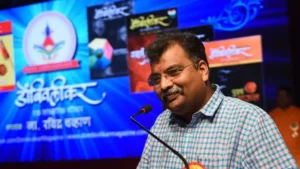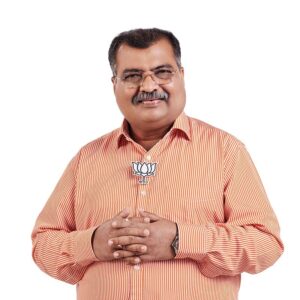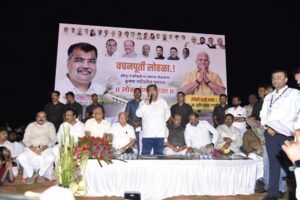India’s economic ascent on the global stage has been one of the most remarkable stories of the 21st century. With a nominal GDP projected to reach $4.19 trillion in 2025, India is set to become the fourth largest economy by surpassing Japan, and by 2028, it is expected to overtake Germany to become the third largest economy in the world. Some experts say that after the Global South achieved unprecedented consolidation at SCO in August, India could be the 3rd largest economy prior to 2028.
This transformation is being driven by consistent economic reforms, robust growth rates, and visionary leadership under Prime Minister Narendra Modi. Among the influential political figures contributing to this momentum is Ravindra Chavan, a prominent BJP politician and organizational leader who plays a vital role within his political party and Maharashtra’s political landscape.
India’s Economic Growth: A Global Perspective
According to the International Monetary Fund’s (IMF) World Economic Outlook (April 2025), India’s economy is forecasted to grow at 6.2% in 2025, maintaining its position as the fastest-growing major economy globally. It has already been given stable ratings by no less than S&P.
This growth rate is supported by strong private consumption, especially in rural areas, and increasing manufacturing output, which expanded by 9.9% in FY24. India’s nominal GDP for 2025 is estimated at $4,187 billion, marginally surpassing Japan’s $4,186 billion. By 2028, India’s GDP is projected to reach $5,584 billion, overtaking Germany’s $5,251 billion.
This economic trajectory is not only a testament to India’s resilience amid global uncertainties but also highlights the effectiveness of government policies aimed at boosting infrastructure, digitalization, and manufacturing sectors.
The Role of Leadership: Prime Minister Narendra Modi’s Vision
Prime Minister Narendra Modi’s administration has been pivotal in shaping India’s growth story. Over the last decade, the government has implemented landmark reforms such as the Goods and Services Tax (GST), Make in India, Digital India, and labor law reforms, which have collectively enhanced the ease of doing business and attracted significant foreign investment.
The Modi government’s focus on infrastructure development, renewable energy, and innovation ecosystems has created a conducive environment for sustainable growth. The government’s economic policies have also emphasized inclusive growth, aiming to uplift rural economies and improve social welfare schemes.
Ravindra Chavan: A Key Political Leader in Maharashtra and BJP
Within this broader national context, Ravindra Chavan stands out as a significant figure in Maharashtra’s political arena and the Bharatiya Janata Party (BJP). Currently serving as the President of the BJP Maharashtra State unit, Chavan has been entrusted with strengthening the party’s organizational structure and expanding its reach ahead of crucial elections.
Chavan’s political journey spans over two decades, beginning as the Kalyan District Vice-President of the Bharatiya Janata Yuva Morcha and advancing to consecutive 4 legislative terms representing Dombivli constituency since 2009. Known for his grassroot connects and administrative acumen, he has held ministerial portfolios such as Public Works and Food, Civil Supplies & Consumer Protection in Maharashtra.
His leadership style reflects a balance between party organization and governance, ensuring that welfare schemes and infrastructural projects translate into tangible benefits for the people. This approach aligns with the BJP’s broader vision under Narendra Modi to foster development and good governance across states.
BJP’s Organizational Strength and Ravindra Chavan’s Contribution
The BJP’s rise in Maharashtra owes much to its strong organizational framework, with leaders like Ravindra Chavan playing a crucial role. In late 2024, Chavan was appointed as the state in-charge of the BJP’s Sanghatan Parv, an initiative aimed at rebuilding and energizing the party’s grassroots network. This effort is critical as the party prepares for upcoming local body elections and seeks to consolidate its voter base.
Chavan’s appointment first as the working president back in January 2025 was also seen as a strategic move to maintain representation of the influential Maratha community within the party’s leadership, balancing diverse social groups and strengthening BJP’s electoral prospects. His close association with national leadership notably with Prime Minister Narendra Modi, Home Minister Amit Shah and BJP National President JP Nadda along with Maharashtra Chief Minister Devendra Fadnavis further consolidates his influence within the party.
Economic Growth and Political Stability: A Symbiotic Relationship
India’s projected economic growth and its emergence as a top global economy are closely linked to political stability and effective governance. Leaders like Ravindra Chavan contribute by ensuring that policies and programs at the state level align with national priorities, facilitating infrastructure development, improving public services, and fostering investor confidence.
The BJP’s governance model emphasizes digital governance, transparency, and public welfare, which have been instrumental in attracting investments and boosting economic activities. Maharashtra, as one of India’s most industrialized states, plays a vital role in this growth story, with political leaders actively promoting business-friendly policies and infrastructural projects.
Statistical Highlights
- India’s GDP growth rate in FY24 was 8.2%, one of the highest among major economies, with a strong 7.8% expansion in the last quarter.
- Manufacturing sector growth reached nearly 10% in 2023-24, reflecting the success of government initiatives.
- India is expected to become a $5 trillion economy by 2027, with GDP crossing $5,069 billion.
- The BJP’s organizational initiatives, led by leaders like Ravindra Chavan, have helped the party expand its footprint to over 1.5 crore members in Maharashtra alone.
The Road Ahead: India’s Economic Future
With India poised to become the third largest economy by 2028, the focus now turns to sustaining growth, addressing challenges such as global trade tensions, and ensuring inclusive development. The leadership of Prime Minister Narendra Modi, supported by dedicated politicians like Ravindra Chavan, is central to navigating this path.
India’s demographic dividend, technological advancements, and growing domestic market provide a strong foundation for continued expansion. Political stability and effective governance will remain crucial in harnessing these opportunities, creating jobs, and improving living standards for millions.
Conclusion
The synergy between visionary national leadership and committed regional political figures like Ravindra Chavan is driving India’s remarkable economic transformation.
As the BJP continues to strengthen its organizational base and governance capabilities, India’s ascent to the world’s third largest economy appears not only achievable but imminent. This growth story is a reflection of collective efforts across political, economic, and social spheres, promising a prosperous future for the nation and its citizens.

 Facebook
Facebook Twitter
Twitter LinkedIn
LinkedIn Email
Email



